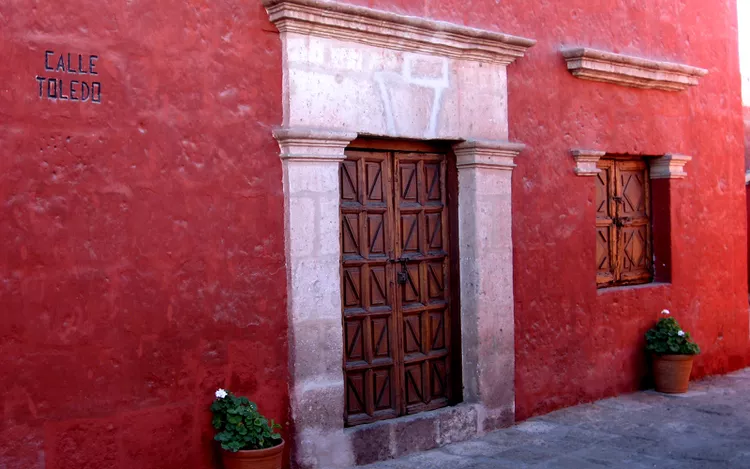Santa Catalina Monastery: A Walled City Within a City
Enter the gates into the adobe brick walled community of the Santa Catalina de Siena Monastery in Arequipa, Peru and step back 400 years in time. A must-see in the White City of Arequipa, Santa Catalina Monastery was begun in 1579/1580, forty years after the city was founded. Consequently, the monastery grew over the centuries, ultimately establishing itself as a city within the city, spanning about 20,000 square meters and covering a sizable block.
History of the Monastery
At one time, 450 nuns and their lay servants resided within the community, isolated from the outside world by high walls. However, in 1970, when civic authorities mandated the installation of electricity and running water, the dwindling community of nuns chose to open the majority of the monastery to the public for financial support. The few remaining nuns retreated to a corner of their community, allowing the monastery to transform into one of Arequipa’s prime tourist attractions.
Constructed from sillar—the white volcanic rock that gives Arequipa its nickname of the White City—and ashlar, or petrified volcanic ash from Volcan Chachani, the monastery was once closed off from the city but now reveals much of its beauty to the intensely blue sky over the southern Peruvian desert.
Highlights of the Monastery
- Cloister of the Oranges (Claustro los Naranjos): The three crosses set among the orange trees serve as the center for the Passion of the Christ ceremonies during the closure of the monastery.
- Silence Yard: Here, nuns walked, recited the rosary, and read the Bible in silence.
- Entrance Portico: Features a statue of St. Catherine of Siena in sillar over the arched doorway.
- Main Cloister: The largest in the monastery, equipped with confessionals and paintings depicting the life of Mary and the public life of Jesus.
- Church: Rebuilt several times after earthquake damage, consistent with the original design, featuring a silver worked altar dedicated to Sor Ana de Los Angeles Monteagudo.
- Cordova Street: A beautiful street reminiscent of Spain, adorned with hanging geraniums on one side.
- Plaza Zocodover: Named after the Arabic word for barter, this area was where nuns gathered on Sundays to exchange their crafts.
- Sevilla Street: Originally leading to the first church of St. Catherine, which was later converted into kitchens.
- Burgos Street: This street connected the vegetable garden to Sevilla Street and the kitchen.
- Laundry Area: Big earthen storage vats used as wash tubs when canals provided Arequipa’s water supply.
As you explore, feel the essence of what life must have been like for the women who lived in seclusion, dedicating themselves to prayer and contemplation. However, history reveals that the early leaders of Arequipa sought their own monastery for nuns. Viceroy Francisco Toledo approved their request, facilitating the establishment of a private monastery for the Order of Saint Catherine of Siena.
Over time, Santa Catalina Monastery attracted numerous women of wealth and social stature. Some new residents even brought their servants and household goods inside the monastery, thus living within a luxurious lifestyle while ostensibly renouncing worldly pleasures. As a result, while many nuns lived in comfort, the monastery retained a sense of spirituality amidst its opulence.
Reforms and Modernization
In the mid-1800s, the monastery became infamous for functioning more as a social club than a religious institution. As a consequence, Pope Pius IX dispatched Sister Josefa Cadena to investigate the situation, initiating a series of reforms. The wealth previously enjoyed by the nuns was reallocated to the motherhouse, leading to a return to austere religious life.
Among the notable figures of the monastery was Sor Ana de Los Angeles Monteagudo (1595 – 1668), who dedicated her life to prayer and service after entering the walls at a young age. Following her death, a petition was submitted for her sainthood, culminating in her beatification by Pope John Paul II in 1985.
Today, with the nuns distanced from the outside world, the Santa Catalina Monastery remains largely unchanged since the 16th and 17th centuries. It wasn’t until the 1970s that civil regulations necessitated modernization efforts, prompting the nuns to open most of the complex for public visitation. Consequently, this allowed visitors a rare glimpse into this historic walled city within a city.
Visit the Monasterio de Santa Catalina
For current visitor information and pricing, check Santa Catalina Monastery’s website. The complex features a cafeteria, souvenir shop, and knowledgeable guides available for tours.
Buen viaje!





